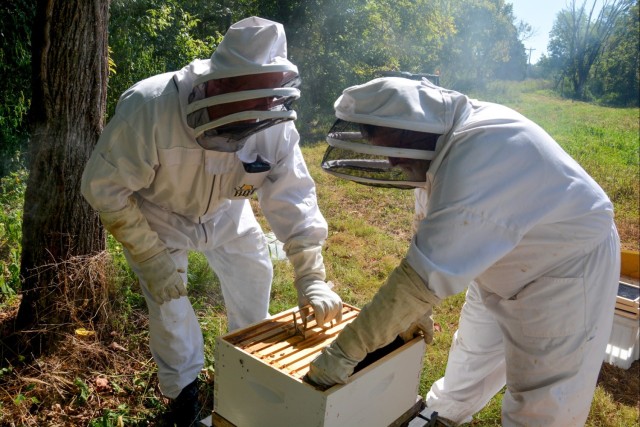
Dubois, Ind. – As the cooler weather of fall begins to chill the air, many creatures take time to prepare for wintertime – including honeybees. Because they do not hibernate, they must take steps to survive until the next spring. Beekeepers can help ensure a hive is successful by lending a helping hand as the little pollinators prepare for the winter.
Jim Merkley, U.S. Army Corps of Engineers, Louisville District park ranger and beekeeper at Patoka Lake, is providing that lending hand for the two hives onsite. He said evaluating the current health of the hives is the first step to fall maintenance.
“Fall maintenance is varied year to year depending on how the bees performed through the summer. It begins with an initial inspection that includes checking on the health of the queen, as well as the amount and condition of brood,” he said. “We also check on the number of bees and the amount of honey that was produced during the past spring and summer. We do this to help prepare the bees for the winter.”
Merkley said the inspection of the hives suggested that several actions be taken to encourage the best outcome in the fall for the honeybees.
“This year fall inspection indicated that we should harvest a little honey and move excess bees along with stored honey from the larger hive to the smaller one. Also, one of our hives was overpopulated while the other hive was struggling with low numbers,” he explained. “This resulted in a recent ‘robbing’ event that occurred when the larger hive invaded the smaller hive and removed all their stored honey.”
Before the bees were divided the larger hive had grown to about 80,000 bees and the smaller one had about 15,000. After maintenance each now have around 30,000-50,000.
“Reducing the population of the larger hive at this time of the year also lessens the chance of a fall swarm. On the other hand, increasing the size of the smaller hive boosts honey reserves helping to give them strength during the upcoming winter,” he added.

Now is a perfect time to make such adjustments as the bees are currently still gathering nectar and pollen from late season flowers to ensure they have enough honey stored for winter.
“Since we split the hives, the bees now have a chance to adjust and adapt to the new configuration while the weather is still nice and before the cold weather hits,” Merkley said.
Merkley said he also performs a late fall checkup and winter prep in late October or early November once the hives have had time to adapt to the current adjustments.
“This will consist of a general check of hive condition, as well as mite treatment. The late fall check will also be the time when I add foam wrappers and inner cover insulation for heat retention. We also partially block the entrance area with an entrance reducer. This will also help keep heat in during the colder months by reducing the amount of airflow through the hive. Reducing the size of the entrance also helps the bees defend themselves, since less bees are flying due to outside conditions, they won’t need as large of an opening.”
Honeybees are a small part of the larger pollinator environment; pollinators are responsible for pollinating fruits, vegetables, and other crops that Americans consume every day. This, in turn, helps the American consumer as well as the United States economy. In addition, the Patoka Lake bees are used to help educate the public on the importance of pollinator health to the nation.


Social Sharing